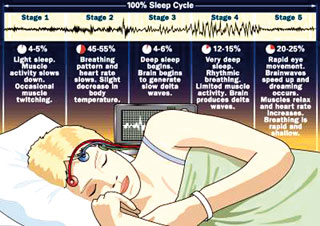|

Brain cells take a break, when you
sleep
Scientists have long wanted to know what happens inside the human
brain when deep asleep. You may be unconscious, but your brain cells are
busy with activity. Neurons, brain cells that conduct electricity, keep
your mind humming even while your body is resting.
In a new study, a team of scientists found that neurons take breaks
periodically as a person heads into deep sleep. These pauses in neuron
activity help keep people asleep, even if they hear noises or are
touched. Sydney Cash, a neurologist at Massachusetts General Hospital
and Harvard Medical School in Boston, and his team found a way to study
electricity in the brain, inside and out.

|

Graphic shows brain activity when sleeping. |
Scientists use different tools to study electrical currents in the
brain. One of the most useful is the EEG, or electroencephalogram.
An EEG represents the brain’s activity as a graph that looks like a
long series of differently shaped waves. The height, width and closeness
of those waves give scientists a peek at what’s happening in a person’s
head. Even though they can study the patterns, however, scientists don’t
know what causes the waves to form.
In the study led by Cash, the researchers were interested in a
particular type of EEG squiggle called a K-complex. To people who don’t
understand EEG patterns, a K-complex just looks like a squiggle that’s
larger than the lines around it.
To a trained scientist, a K-complex shows a significant change in the
electrical activity in the brain. A K-complex may show up on an EEG when
the sleeping person hears a noise or has his or her sleep disturbed. Or
these squiggles may show up for other reasons.
EEGs can’t see everything, however. They only measure electric
signals “including K-complexes” on the outside of the brain.In the new
study, the scientists found a way to see even deeper into the brain.
They studied patients with epilepsy, a medical condition that can cause
a person to suffer from serious seizures.
Epilepsy is believed to be caused by overactive neurons. In previous
surgeries, the people with epilepsy had had tiny electrodes implanted
deeper inside their brains. Electrodes are also used to study electrical
currents, and doctors had hoped that these devices would help them
identify the source of the epileptic seizures.
Cash, who studies epilepsy, realised that those same electrodes could
be used to study electrical activity deeper inside the brain while at
the same time an EEG told the scientists what was happening on the
surface.
By comparing the two sets of information, the scientists thought they
could better understand brain activity.They were right. While the
patients slept, Cash and his team collected data from both the EEG and
from the electrodes.
They found that whenever the EEG showed a K-complex, there was a dip
in activity inside the brain. In other words, the K-complex was a sign
on the outside that neurons on the inside were taking a break.
These breaks help keep people asleep. Cash’s research also shows that
K-complexes don’t spread to the entire brain, which means that only some
neurons take a break at any given time.
The brain has long been one of the most mysterious parts of the human
body. Studies like this one help scientists open a window onto the inner
workings of our heads and possibly figure out how the circuitry works.
Understanding how neurons behave is important, but scientists also need
to know what these cells do when they’re not at work. As this study
shows, neurons take a break, so you can too.
Science Daily |

